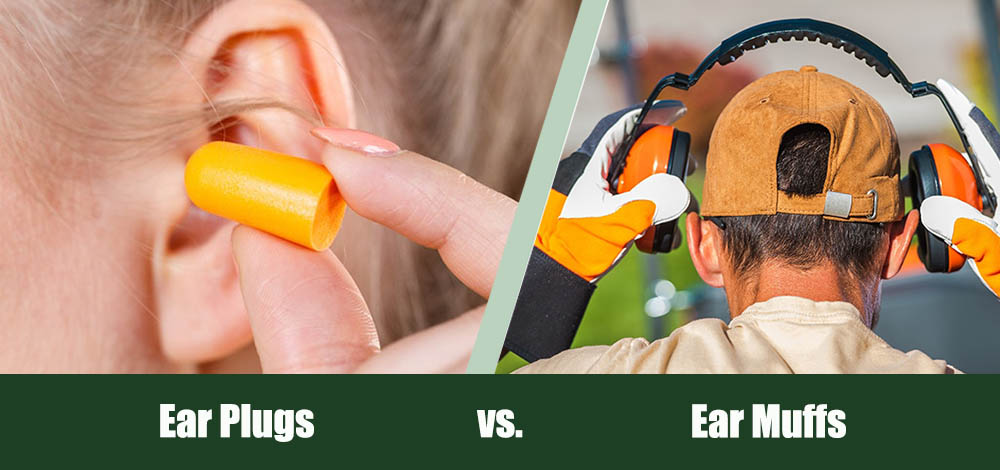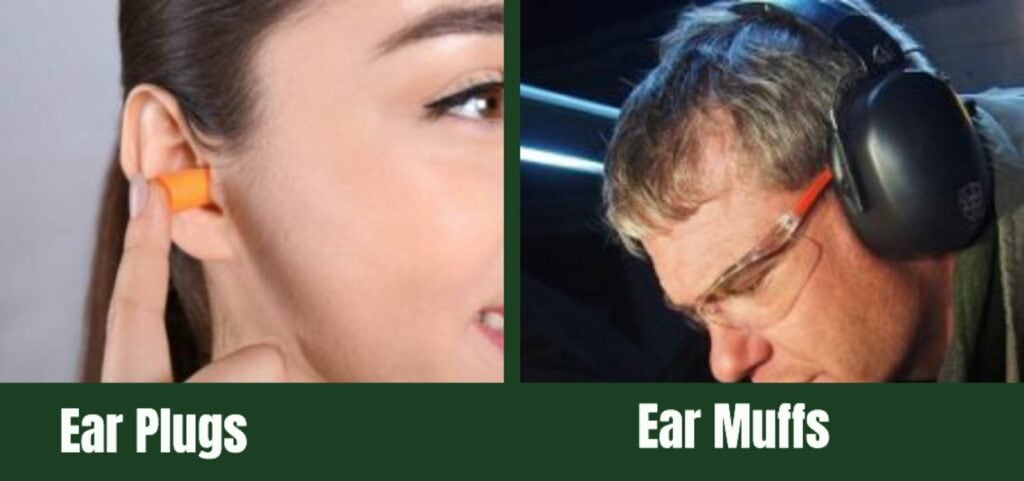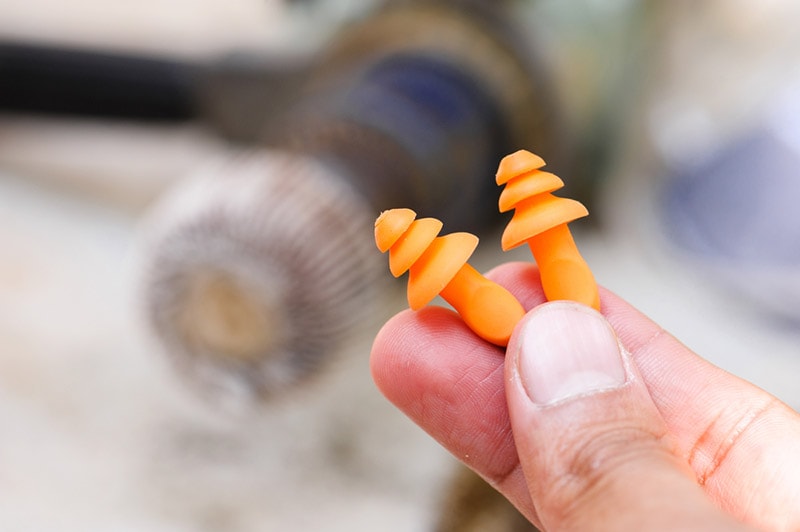Ear Plugs vs. Ear Muffs: What’s The Difference?
-
Brooke Bundy
- Last updated:

Have you ever heard the sound of your lawn mower still humming in your ears even after you’ve turned it off? Over time, those Saturday afternoon hours can have a negative effect that lingers long after the humming noise has gone away. Hearing loss can result from repetitive exposure to loud noise. Even 2 hours of constant unprotected exposure to sound at 85 decibels1, such as a gas-powered leaf blower, can potentially cause hearing damage. Ear plugs and ear muffs are both designed to protect your hearing. Either one can be used on a job site, although employers typically prefer ear plugs since they’re cheaper to provide. Although a lot of people say ear plugs are superior to ear muffs over all, it really depends on how they fit and how comfortable you are wearing them.
 At a Glance
At a Glance

- Fits inside ears
- Doesn’t take up much space
- Works better with other PPE or glasses
- Inexpensive
- Protects ears from the outside
- More sanitary
- Easy to find
- Slips on and off effortlessly
Ear Plugs
Nowadays, ear plugs are more commonly used than ear muffs. They’re more discreet, easier to carry, and are oftentimes cheaper. However, they’re not superior in every situation, as we’ll see in a minute.

Different Types of Ear Plugs
Ear plugs are made out of soft molded silicone that can either be tailored to your ears, or mass-produced in pre-molded sizes. While most earplugs are fairly basic and inexpensive, some come with special features such as electronic noise control or cords so that you can find them easily.
Expandable foam plugs are easier to fit into your ears than reusable, pre-molded ones that are already sized. Additionally, some people find that they must buy a different size of the pre-molded type to fit in each ear.
Ideally, a pair of custom-made earplugs will work better than disposable expandable foam, or a pre-molded one-size-fits-all pair. It’s not really sanitary to have to roll your own earplugs in the middle of a work environment, and the pre-molded ones aren’t doing you any favors if they don’t fit properly.
Why People Prefer Ear Plugs
According to OSHA rules, employers must provide employees with hearing protection if the work environment necessitates it. Since ear plugs are considerably cheaper than ear muffs, they are automatically the favorite choice among most employers. Some workers might also agree on different grounds since they’re much more compliant with other PPE and glasses. Hobbyists may prefer ear plugs because they don’t take up so much space and don’t generate as much heat as ear muffs, which can be stifling in hot, humid weather.
Why Ear Plugs Aren’t Always the Best
While earplugs are often touted as the best choice of hearing protection, they only work if you’re wearing them properly. It can be hard to make earplugs fit well, especially if you have a smaller ear canal. They can also cause ear irritation in sensitive individuals. Furthermore, rolling them in the middle of a task isn’t very sanitary since you’re going to put them inside your ears.
- Discreet to wear and easy to carry
- Works well with other PPE and eyeglasses
- Inexpensive
- Different options available, including expandable foam, reusable plugs, and custom-made
- Can be challenging to find the right fit
- Rolling expandable foam plugs in the middle of a task isn’t sanitary
- May cause ear irritation
Ear Muffs
They may be boxy and cumbersome, but there are several reasons ear muffs may still be a better option than ear plugs.

How They Work
Ear muffs cover your ears. The muffs are hard plastic on the outside and feature a soft foam on the inside. The outer layer blocks loud noises while the foam on the inside absorbs residual sound waves and cushions your ears.
Why Some People Prefer Ear Muffs
Ear muffs are definitely preferred over ear plugs for tasks that require you to still be able to hear. You can easily slip a pair of ear muffs on and off your head, as opposed to taking the time to put in and take out ear plugs. Individuals with small or sensitive ear canals may also choose ear muffs since they stay outside the ear canal. Finally, ear muffs aren’t as easily displaced due to their larger size.
Why Ear Muffs May Not Be the Best Choice
If you work in a hot, humid climate, you don’t really want to add extra layers of warmth to your body. Ear muffs trap sound waves—and heat waves—and can make your head miserably hot. They also can feel clunky and awkward due to their large size, and they don’t easily accommodate glasses or other PPE equipment. Employers might not choose ear muffs as their PPE of choice because they’re also more expensive to provide. The plus side though is that they’re reusable, so it’s a one-time investment as opposed to continuously purchasing ear plugs.
- Safer choice for small or sensitive ear canals
- Easier to put on and remove
- Higher visibility means they’re harder to lose
- Traps heat
- More expensive than ear plugs
- Doesn’t work well with glasses or other PPE
Ear Plugs vs. Ear Muffs
Now that you know the difference between ear plugs and ear muffs, let’s look at the reasons why you’d choose one over the other, as well as which one is safer.
Are Ear Plugs or Ear Muffs Safer?
Since ear plugs fit inside your ears, most people would say that they’re more effective at protecting your hearing than ear muffs. This is partially true. If your ear muffs don’t conform well to your head, the gaps can allow damaging sound waves to travel into your ear canal. However, the same can be said for ear plugs. Wearing ear plugs that don’t fit well, or wearing them improperly, can also damage your hearing as if you weren’t wearing any PPE at all. The safest choice is whichever one works best for you.
- For a long task where you’ll need hearing protection for an extended period of time
- You need an inexpensive option
- You wear glasses or other PPE
- Hot, humid weather
- Out in the rain
- Tasks that require you to be able to hear some of the time
- Unsanitary conditions that would make rolling ear plugs dangerous
- You have a small or sensitive ear canal, or are prone to ear infections
- If you’d rather make a one-time investment
- You don’t want to lose your PPE
Conclusion
Although both ear plugs and ear muffs perform the same function, they have their own strengths and weaknesses which may make one a better choice than the other for a particular task. In the end, it’s up to you to decide what’s best to protect your hearing. As long as they fit and don’t cause discomfort, both are valid choices, and may be required at your workplace depending on what you do. Since hearing damage can be caused by everyday appliances and tools at your house, you probably want to acquire some personal hearing protection to use as you conduct loud tasks such as blowing leaves off the lawn or sawing in the shed.
See Also: STIHL Ear Muffs Review – Pros, Cons & Final Verdict
- https://hearillinois.com/hearing-health-blog/3-types-of-ear-protection
- https://www.headphonesty.com/2020/04/earplugs-vs-earmuffs/
- https://www.safeopedia.com/are-earplugs-always-better-than-earmuffs/7/8916
- https://www.safeopedia.com/are-you-wearing-your-earplugs-properly-it-might-be-destroying-your-hearing/2/7377
- https://www.cdc.gov/nceh/hearing_loss/what_noises_cause_hearing_loss.html
- https://www.cdc.gov/niosh/topics/noise/choose.html
See also:
Featured Image Credit: (L) Anetlanda, Shutterstock | (R) Virrage Images, Shutterstock
Contents
 At a Glance
At a Glance